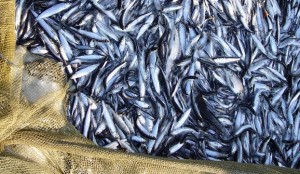
Industry reports of steadily increasing fish catches over 40 years, it turns out, left something out.(Photo by ezioman/Flickr)
A new study of industrial fishing practices has found that the world’s fish catch peaked 20 years ago and has been declining since. Worse, it finds that the steady increases in the catch prior to the 1980s were achieved not because there were lots of fish, but because the industry constantly moved to new fisheries, leaving behind depleted ones. Now, they have run out of places to go.
The study, conducted by the University of British Columbia and the National Geographic Society, found that the world catch of fish went from 19 million metric tons in 1950, when the UN Food and Agriculture Organization (FAO) began compiling records, to 90 million metric tons per year in the late 1980s. The steady increases were cited by the industry as evidence that the fisheries were healthy and productive. In fact, the new research shows, the industry was exhausting and abandoning fishing ground after fishing ground, masking the depletion by moving to unexploited areas.
The fishing being described here is not the romantic, man-against-the-sea, Perfect-Storm kind of fishing that the industry likes to envision, just as Big Agriculture talks constantly about the mom-and-pop, American-Gothic family farm as if that was the face of agriculture today (similarly, Mafia dons present themselves as proprietors of pizza shops). Today’s fishing is done by mammoth floating factories that are not only trawlers but have on-board processing plants and frozen storage facilities.
Industrial fishingon such a scale began in the 1950s, in the North Atlantic and Western Pacific, off the shores of the most industrialized countries. Its period of greatest expansion and largest catches, beginning in the mid-1980s, was a time in which the catches in established grounds were actually rapidly decreasing, and the trawlers were edging southward into fresh new fish concentrations at a rate of a degree of latitude every year. Now, says the report, there is virtually nowhere left to go, leaving “only unproductive waters of high seas, and relatively inaccessible waters in the Arctic and Antarctic as the last remaining ‘frontiers.’ ”
After the 90-million-tonne high point, the world catch fell to 87 million in 2005, the last year covered by this study, and continued to plummet to fewer than 80 million in 2008, according to the FAO. Yet last week, the International Commission for the Conservation of Atlantic Tunas could not bring itself to impose anything more than perfunctory limits on catches of the deeply imperiled blue-fin tuna or swordfish.
In the fishing industry as with agriculture, as the rush toward catastrophe accelerates, the regulators and the governments serve the interests of the industry and ignore the consequences.